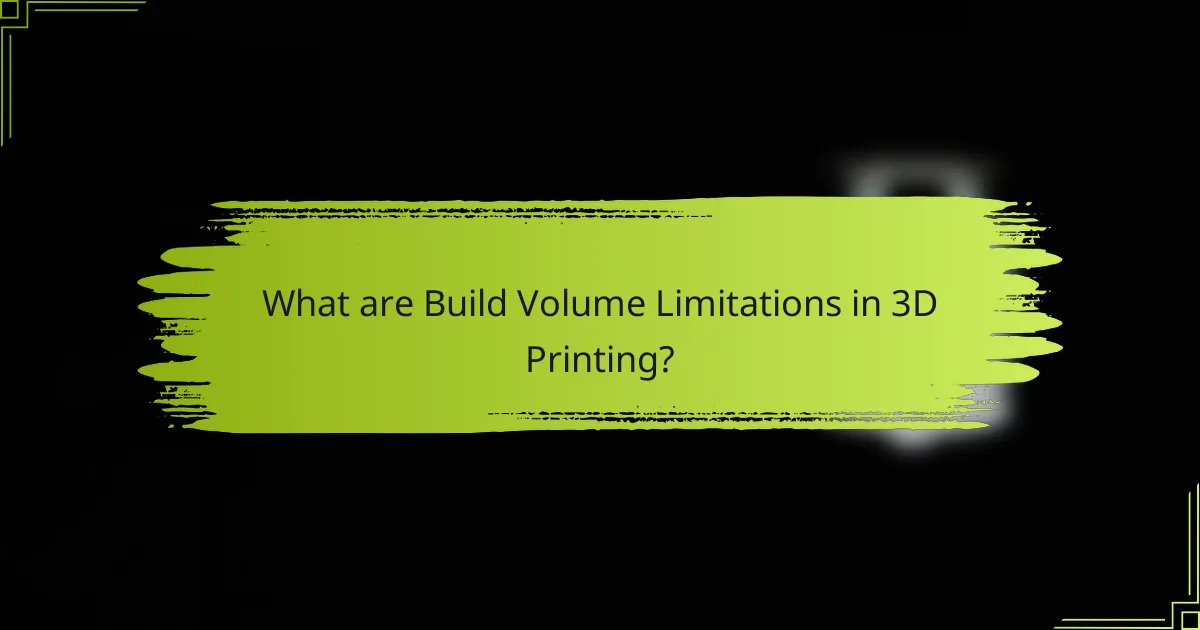
What are Build Volume Limitations in 3D Printing?
Build volume limitations in 3D printing refer to the maximum dimensions of an object that a printer can create. These limitations are determined by the printer’s design and specifications. Each 3D printer has a specific build volume, often measured in millimeters, which defines the length, width, and height of the objects it can print. For example, a printer with a build volume of 300x300x400 mm can only print objects that fit within those dimensions.
If an object exceeds these dimensions, it cannot be printed in a single piece. This limitation affects the design process, requiring adjustments to meet the printer’s capacity. Additionally, larger objects may require more time and resources to print. Understanding these limitations is crucial for effective 3D printing.
How do build volume limitations impact the 3D printing process?
Build volume limitations restrict the size of objects that can be printed in 3D printing. These constraints affect the design and complexity of models. Smaller build volumes may require parts to be divided into multiple pieces. This can lead to increased assembly time and potential misalignment issues. Additionally, limited build volume can hinder the production of larger prototypes or functional parts. It may also necessitate the use of support structures, which can complicate the printing process. Furthermore, designers must consider these limitations during the design phase to optimize the use of available space. Ultimately, build volume constraints can influence material usage and printing efficiency.
What factors contribute to the size of the build volume?
The size of the build volume in 3D printing is influenced by several factors. The printer’s design and engineering play a crucial role. The dimensions of the frame and the movement mechanism determine the maximum printable area. Additionally, the type of 3D printing technology affects build volume. For example, FDM printers typically have larger volumes compared to SLA printers. The size of the print head and the range of motion of the axes also contribute to the build volume. Furthermore, the materials used can impose limitations on the size due to their handling requirements. Lastly, the intended application of the printer may dictate the necessary build volume, as different projects require different sizes.
How do different 3D printing technologies affect build volume?
Different 3D printing technologies significantly influence build volume. Fused Deposition Modeling (FDM) typically offers larger build volumes due to its simpler design. Stereolithography (SLA) usually has smaller build volumes because of its reliance on a resin tank. Selective Laser Sintering (SLS) can accommodate medium to large build volumes depending on the printer model. Digital Light Processing (DLP) shares similar limitations as SLA regarding build volume. Binder Jetting often supports larger volumes but varies by machine specifications. Each technology’s unique mechanics and material requirements directly impact the maximum dimensions achievable in a single print.
Why is understanding build volume important for users?
Understanding build volume is crucial for users because it dictates the maximum size of objects they can print. This limitation affects project feasibility and design choices. Users must know their printer’s build volume to avoid attempting prints that exceed these dimensions. Exceeding the build volume can lead to failed prints and wasted materials. Additionally, understanding build volume helps users optimize their layouts and reduce print times. It also influences the selection of appropriate 3D printing technologies. Accurate knowledge of build volume enhances overall user satisfaction and efficiency in 3D printing projects.
How does build volume influence design considerations?
Build volume significantly influences design considerations in 3D printing. It determines the maximum dimensions of the object that can be printed. Designers must ensure that their models fit within these constraints. If the design exceeds the build volume, it cannot be printed as intended. This limitation often requires designers to rethink the object’s scale or structure. They may need to segment larger designs into smaller parts. Each part must be designed for reassembly post-printing. Additionally, the build volume affects material usage and print time. Larger volumes typically require more material and longer print durations. Thus, understanding build volume is crucial for effective design in 3D printing.
What are the implications of exceeding build volume limits?
Exceeding build volume limits can lead to print failures or incomplete models. When a 3D print exceeds the defined dimensions, the printer cannot accommodate the part. This results in the print being cut off or not starting at all. Additionally, exceeding these limits can cause damage to the printer’s components. For example, the extruder may become jammed or misaligned. Furthermore, it can lead to wasted materials and increased costs. Accurate adherence to build volume specifications is essential for successful printing.

What Challenges Arise from Build Volume Limitations?
Build volume limitations in 3D printing pose several challenges. These limitations restrict the size of objects that can be printed in a single run. As a result, larger designs may require multiple prints, leading to increased time and material usage. Additionally, aligning and assembling multiple parts can introduce inaccuracies. Limited build volume also affects the complexity of designs, as intricate features may need to be simplified. This can compromise the functionality or aesthetics of the final product. Furthermore, smaller build volumes may necessitate the use of more advanced printing techniques, which can increase costs. Overall, these challenges can hinder the efficiency and effectiveness of the 3D printing process.
What common challenges do users face with build volume?
Users face several common challenges with build volume in 3D printing. Limited build volume restricts the size of objects that can be printed. This limitation can lead to the need for multiple prints or assembly of parts. Users may encounter issues with fitting larger designs within the printer’s constraints. Additionally, small build volumes can hinder the creation of complex geometries. Users often struggle with optimizing designs to maximize the use of available space. Some users also experience difficulties in aligning parts accurately during assembly. These challenges can affect the overall efficiency and effectiveness of the 3D printing process.
How do material constraints affect build volume usage?
Material constraints directly limit the effective build volume usage in 3D printing. The type and quantity of material available dictate the maximum size and complexity of printed objects. Insufficient material can lead to incomplete prints or necessitate smaller designs. Additionally, certain materials require specific conditions that may further restrict build volume. For example, some materials may need a heated chamber to prevent warping, limiting the types of objects that can be printed simultaneously. Studies show that material properties, such as shrinkage and adhesion, influence how much of the build volume can be effectively utilized. Therefore, understanding material constraints is crucial for optimizing design and production processes in 3D printing.
What are the limitations in printer design that restrict build volume?
Printer design limitations that restrict build volume include the size of the print bed, the movement range of the print head, and the structural stability of the printer. The print bed size determines the maximum dimensions of the object that can be printed. Limited movement range of the print head can restrict the height and width of the print. Structural stability is crucial; any flexing or bending can lead to inaccuracies in larger prints. Additionally, the design of the frame can limit the overall build space. These factors collectively constrain the build volume in 3D printers.
How do build volume limitations affect project outcomes?
Build volume limitations restrict the size of objects that can be produced in 3D printing. These constraints can lead to incomplete designs if the object exceeds the printer’s capacity. Projects may require multiple parts to be printed separately, increasing assembly time. This can also impact the structural integrity of the final product. Additionally, limited build volume can necessitate design alterations, potentially affecting functionality. According to a study by Huang et al. (2017), projects often face delays and increased costs due to these limitations. Overall, build volume constraints can significantly influence the efficiency and outcome of 3D printing projects.
What are the consequences of limited build volume on production time?
Limited build volume increases production time. Smaller build volumes require multiple print jobs for larger objects. Each job incurs setup time and material preparation. This fragmentation leads to inefficiencies in workflow. Additionally, the need for assembly of printed parts extends overall project duration. Research indicates that larger build volumes can reduce print cycles significantly. Studies show that optimizing build volume can improve throughput by up to 30%. Thus, limited build volume directly correlates with longer production timelines.
How can limited build volume impact the quality of printed objects?
Limited build volume can negatively impact the quality of printed objects. A smaller build area restricts the size of the objects that can be printed. This limitation may require parts to be printed in multiple sections. Assembling these sections can lead to misalignment and visible seams. Additionally, intricate designs may be compromised due to size constraints. The printer may also need to use more supports, which can affect the surface finish. Furthermore, limited volume can restrict the use of certain materials that require larger print spaces. Ultimately, quality may suffer due to these factors, resulting in less precise and aesthetically pleasing prints.

What Solutions Exist for Overcoming Build Volume Limitations?
Solutions for overcoming build volume limitations include using modular design, which allows for the assembly of larger parts from smaller printed components. Another approach is employing multi-material printing, enabling the combination of various materials to create complex structures. Additionally, utilizing larger 3D printers increases the build volume directly. Techniques such as tiling or nesting parts can maximize space within the printer. Furthermore, post-processing methods like assembly or welding can combine multiple printed sections into a single large object. These solutions effectively address the constraints posed by limited build volumes in 3D printing.
What strategies can be employed to maximize build volume effectively?
To maximize build volume effectively, consider optimizing the layout of printed parts. Efficiently arranging multiple parts can reduce wasted space. Utilize support structures that minimize material use while maintaining stability. Adjust print orientation to enhance surface area exposure to the build plate. Select appropriate slicing settings to increase layer adhesion and reduce warping. Employ larger build plates when available to accommodate bigger designs. Use advanced software tools to analyze and simulate part placement. These strategies collectively enhance the utilization of available build volume in 3D printing.
How can modular designs help in utilizing build volume?
Modular designs optimize build volume by allowing for efficient spatial arrangement of components. They enable the division of larger objects into smaller, manageable parts. This approach minimizes wasted space during the printing process. Each module can be printed independently and assembled later. This flexibility enhances the use of available build space. Research indicates that modular designs can increase overall print efficiency by up to 30%. They also facilitate the printing of complex geometries that would otherwise exceed build limits. Overall, modular designs significantly improve the utilization of build volume in 3D printing.
What role does slicing software play in addressing build volume issues?
Slicing software is essential for managing build volume issues in 3D printing. It translates 3D models into instructions for the printer. This software allows users to adjust model size and orientation. Users can also split larger models into smaller parts. This ensures that each part fits within the printer’s build volume. Additionally, slicing software can optimize model placement on the print bed. It can maximize space and reduce material waste. By addressing these factors, slicing software enhances the efficiency of 3D printing processes.
What advancements in technology are helping to overcome build volume constraints?
Advancements in technology that help overcome build volume constraints include large-format 3D printing and modular printing systems. Large-format 3D printers utilize extended print beds to create larger objects in a single build. Modular printing systems enable multiple printers to work in tandem, effectively increasing overall production capacity. These technologies allow for the creation of larger components without the need for assembly. Additionally, continuous 3D printing methods, such as CLIP (Continuous Liquid Interface Production), enable faster production of larger parts by eliminating layer-by-layer constraints. These advancements demonstrate significant improvements in efficiency and scalability within the 3D printing industry.
How are larger 3D printers changing the landscape of build volume?
Larger 3D printers are significantly expanding the build volume capabilities within the industry. This increased capacity allows for the production of larger and more complex parts in a single print. As a result, manufacturers can create functional prototypes and end-use products without the need for assembly. The ability to print larger objects reduces material waste and improves efficiency. Additionally, advancements in materials compatible with larger printers enhance the strength and durability of printed items. According to a report by Wohlers Associates, the global 3D printing industry is projected to reach $35.6 billion by 2024, driven in part by these larger printers. This trend indicates a shift towards more versatile applications across various sectors, including aerospace and automotive.
What innovations in materials are expanding the possibilities of build volume?
Innovations in materials such as advanced polymers, metal composites, and bio-based materials are expanding build volume possibilities in 3D printing. Advanced polymers, like nylon and TPU, offer flexibility and strength, allowing for larger and more complex designs. Metal composites enhance durability while maintaining lightweight characteristics, enabling the creation of intricate structures. Bio-based materials, derived from renewable resources, provide eco-friendly options that can be printed in larger volumes. Research has shown that these materials can be utilized in high-performance applications, significantly increasing the potential for larger builds. For instance, the use of carbon fiber-reinforced filaments can improve the mechanical properties of printed objects, allowing for larger and more functional parts.
What best practices can users adopt to navigate build volume limitations?
Users can adopt several best practices to navigate build volume limitations effectively. First, they should optimize their designs for smaller parts. This allows for printing multiple components that can be assembled later. Second, users can utilize supports and rafts to enhance stability during printing. This is crucial for intricate designs that may otherwise fail. Third, they should consider using a slicing software that allows for better layout management. This can maximize the use of available build space. Fourth, users can explore modular designs. Modular designs can be printed separately and joined post-printing. Finally, they can adjust print orientation to fit larger objects into the build volume more efficiently. These practices help users make the most of their 3D printer’s capabilities.
Build volume limitations in 3D printing define the maximum dimensions of objects that a printer can create, impacting design, production efficiency, and material usage. This article explores the factors influencing build volume, such as printer design and technology, and discusses the challenges users face, including the need for part segmentation and assembly. Additionally, it examines solutions to overcome these limitations, including modular design, advancements in technology, and best practices for optimizing print layouts. Understanding these aspects is essential for enhancing the effectiveness of 3D printing projects.